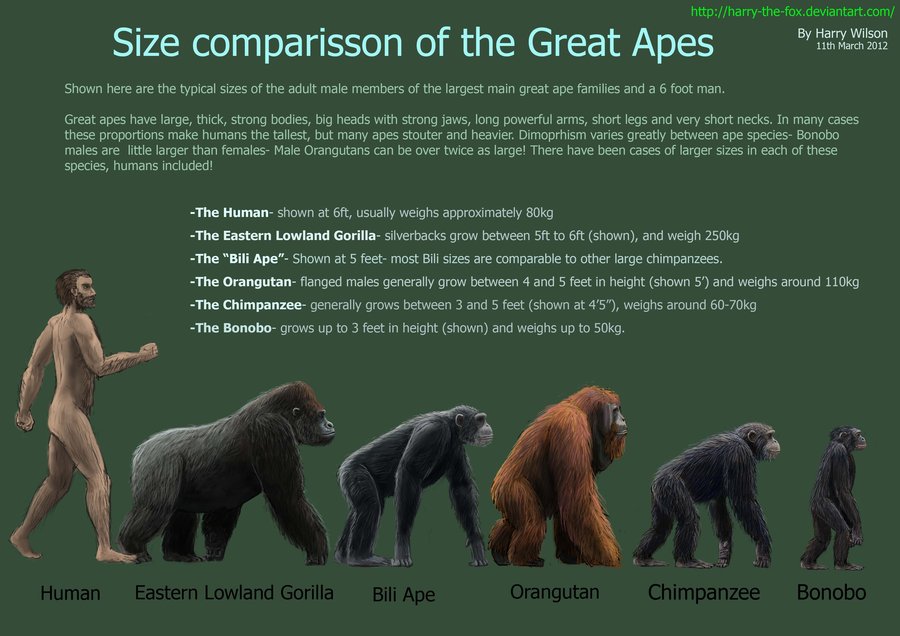

Gorillas spend more time on the ground than other apes, therefore their feet are more suited to walking. For instance, the gorillas' hands and feet resemble the human ones more than those of other apes. In mitochondrial DNA, which changes considerably faster, geneticists found a difference in 8.8% between humans and chimpanzees, 10.3% between humans and gorillas, 10.6% between chimpanzees and gorillas and 16-17% difference between the other species and the orang-utan.Īlthough chimpanzees and bonobos are the closest relatives of humans, gorillas resemble us more in some respects. Apes do not have tails, while most monkey species do. In contrast, analyzed parts of the genetic material of African apes and humans differ from the respective genetic material of the orang-utan by about 3.1%. The quickest and easiest way to tell monkeys and apes apart is by looking for a tail. Certain genes that were analyzed differ by only 1.2% between humans and chimpanzees, by 1.6% between humans and gorillas and by 1.8% between gorillas and chimpanzees. Differences are especially small in the nuclear DNA. The genetic material of apes is identical to that of humans to a very large degree. A difference between gorillas and other apes is that, chimpanzees and bonobos make positive contact with each other through eye contact, while gorillas. The orang-utans are only remotely related to the other species. According to their research, the chimpanzees are the closest relatives of humans the next in line are the gorillas. More recently, most experts have concluded that this view is out of date. This division was based on certain anatomical specialisations, mainly the highly developed human brain and the unique locomotion. (system supported by DigitalSiber.In former times, the human species used to be put into its own taxonomic family (Hominidae), while the great apes were put in a different family, Pongidae. So there may still be inaccuracies in translating, please always see Indonesian as our main language. The English, Chinese, Japanese, Arabic, French, and Spanish versions are automatically generated by the system. This forms a movement called knuckle-walking. While the Gorilla walks on both feet with the help of both hands and fists. In addition, Chimpanzees can walk upright on two legs when carrying things with both hands.

The bodies of these two primates are also hairy, except for the fingers, face, armpits, palms and feet. This gene is closely related to the cause of the autism spectrum.įor physical characteristics, gorillas and chimpanzees have similarities in the size of the arms that are longer than the legs. In mitochondrial DNA, which changes considerably faster, geneticists found a difference in 8.8 between humans and chimpanzees, 10.3 between humans and. (Italo Melo/Pexels)įinally, in this study also found the MET gene in humans is higher in expression compared to gorillas and chimpanzees. "It is very likely that this TH gene was once present in primates, but has disappeared and reappeared in the human lineage," said Sousa. Both found that TH was present in the brain cortex and striatum of humans but not in chimpanzees.

Sousa and Ying Zou, vice chair of the research also focused on the TH gene that functions to produce the hormone dopamine. In addition, the researchers also found a gene called ZP2 which is only active in the human cerebellum. Differences were also found in the cerebellum region. The brain region that distinguishes humans and primates is in the striatum, an area closely related to movement. "But there are also small differences between the species, namely how individual cells function and form connections," added the man who was the lead author of the study. "The human brain is three times larger, has more cells and therefore processes more energy than chimpanzees and monkeys," said Andre MM Sousa, a postdoctoral researcher from the laboratory of neuroscientist Nenad Sestan. This is what primates lack even though almost all regions of the human brain have molecular characteristics that closely resemble those of chimpanzees and gorillas. University researchers formulate that several parts of the human brain contain patterns of human gene activity that contribute to cognitive abilities. It is said so because almost 97-98 percent of gorilla and chimpanzee DNA is identical to human DNA.Īlthough they have almost the same genetic material, a study conducted at Yale University in the United States found that the significant difference between the two primates lies in the part of the brain. JAKARTA - Gorillas and chimpanzees are two types of primates that are often considered as "distant relatives" of humans.


 0 kommentar(er)
0 kommentar(er)
